**This post describes an entirely hypothetical asteroid impact scenario, that played out during this year’s Planetary Defense Conference**
Conference wrap-up
Take home messages:
— Asteroid impacts are the only natural disaster we can prevent
— With good observations, we can have years – decades or even centuries – to prepare for a potential asteroid impact
— Astronomers, amateur-astronomers, space agencies and observatories are constantly monitoring our skies. ESA’s upcoming Flyeye telescope will play a vital role in the search for risky space rocks
— Asteroids move in defined orbits – they are predictable! Once we’ve found an asteroid and observed it over a period, we can determine where it will be at any point in the future and therefore understand if it will ever pass close to Earth.
— ESA’s Near-Earth Object Coordination Centre (among others) is constantly determining the paths of near-Earth asteroids, and calculating their risk. All this information is publically available! Subscribe to the monthly asteroid newsletter and check out the website, here
— Asteroid deflection is a reality – a global collaboration will see NASA fly their DART, ‘Double Asteroid Redirection Test’, spacecraft into the Didymoon asteroid, with the aim of altering its orbit. ESA’s Hera mission will follow up and observe the effect – a vital part of understanding the effects of a ‘kinetic impact’. Find out more, here
— Fortunately, we don’t get much practise in responding to large asteroid impacts. This means hypothetical impact scenarios are a vital tool in planning for a variety of worst case scenarios. (This year, much of the fictional asteroid 2019 PDC was deflected using multiple kinetic impactors, however the ‘head’ of this contact binary remained on a collision course with Earth, set to destroy New York. Questions about reconnaissance missions, nuclear options and evacuation and emergency preparedness became vital to the international response. See below for a day-to-day break down of what happened.)
— Find out more about ESA’s work to protect our planet here: www.esa.int/SpaceSafety
Friday 3 May: Day five
Ground-based observations, including ranging measurements by the Arecibo Observatory in Puerto Rico, have narrowed down the impact area. 2019 PDC is predicted with certainty to impact over the Central Park area in New York City – just 10 days from now.
The U.S. Federal Emergency Management Agency has requested daily updates from the International Asteroid Warning Network on the predicted impact location and damage estimates, in order to finalise their evacuation of residents and critical infrastructure and to prepare for any casualties and ultimately recovery efforts.
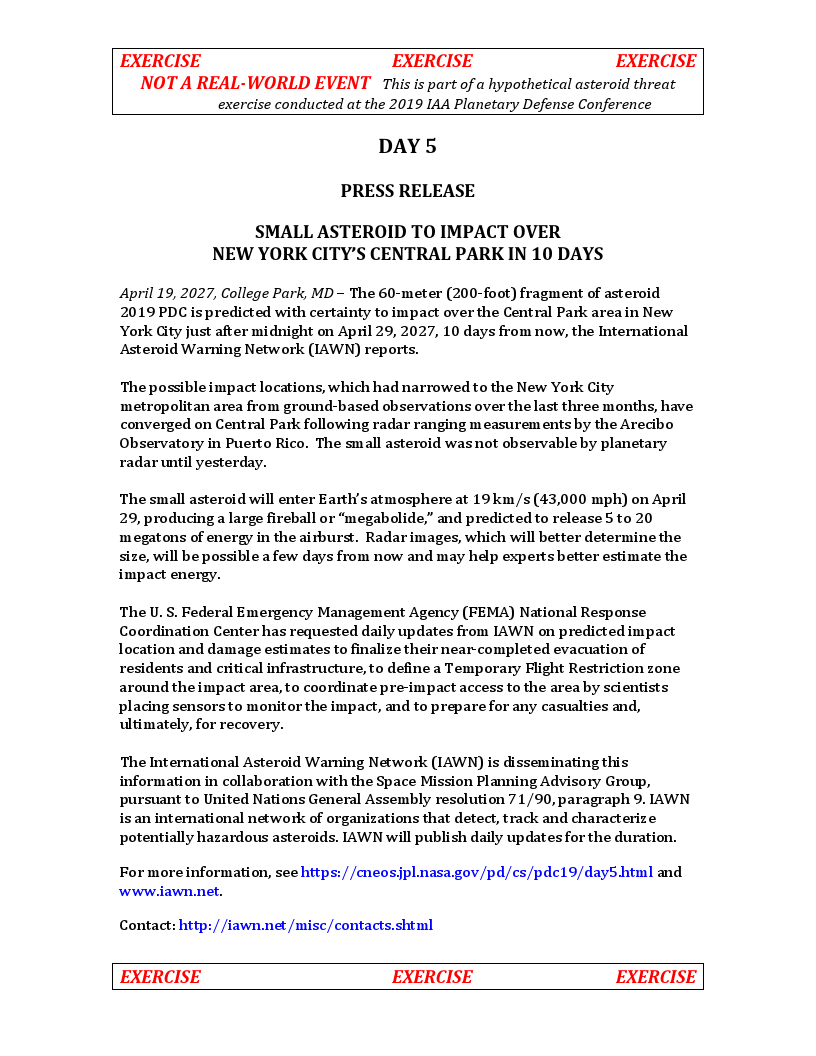
More details are coming in on the final twitter thread from ESA Operations:
#FictionalEvent
Possible impact locations narrowed as ground-based observations over the last three months, and following radar 'ranging' measurements by the Arecibo Observatory in Puerto Rico, converged on Central Park #PDC2019 pic.twitter.com/vpazx8NsHH— ESA Operations (@esaoperations) May 3, 2019
Thursday 2 May: Day four
3 September 2024
In response to hypothetical asteroid #2019PDC – set to impact Denver, Colorado – three ‘kinetic impactor’ missions were sent to crash into the space rock and nudge its orbit away from Earth. The missions successfully deflected its main body, however, a 50-80-metre fragment is currently still certain to collide with Earth. The new impact site is unknown, but the Eastern United States and Atlantic ocean are currently at risk.
Find out more in the fourth press release in this year’s impact scenario:

 Check out the latest Twitter thread with highlights from today’s announcement:
Check out the latest Twitter thread with highlights from today’s announcement:
#FictionalEvent
Earth impact is (hypothetically) certain. The exact location is not known, but the Eastern United States and Atlantic ocean are at risk. pic.twitter.com/pxri27n8aL— ESA Operations (@esaoperations) May 2, 2019
Catch our Facebook live interview on the penultimate morning of the Planetary Defense Conference, with ESA’s Juan Luis Cano, NASA’s Kelly Fast and Romana Kofler from the United Nations Office for Outer Space Affairs (left to right).
https://www.facebook.com/EuropeanSpaceAgency/videos/336843827190534/
Wednesday 1 May: Day three
30 December 2021:
It was decided that a reconnaissance mission was necessary to understand more about fictional asteroid 2019 PDC’s orbit, size and composition. More than two years after the asteroid was detected, the reconnaissance mission has now discovered is that the 200-m asteroid is on a certain collision course with Denver, Colorado in the United States of America.
Here is the third (fictional) press release:
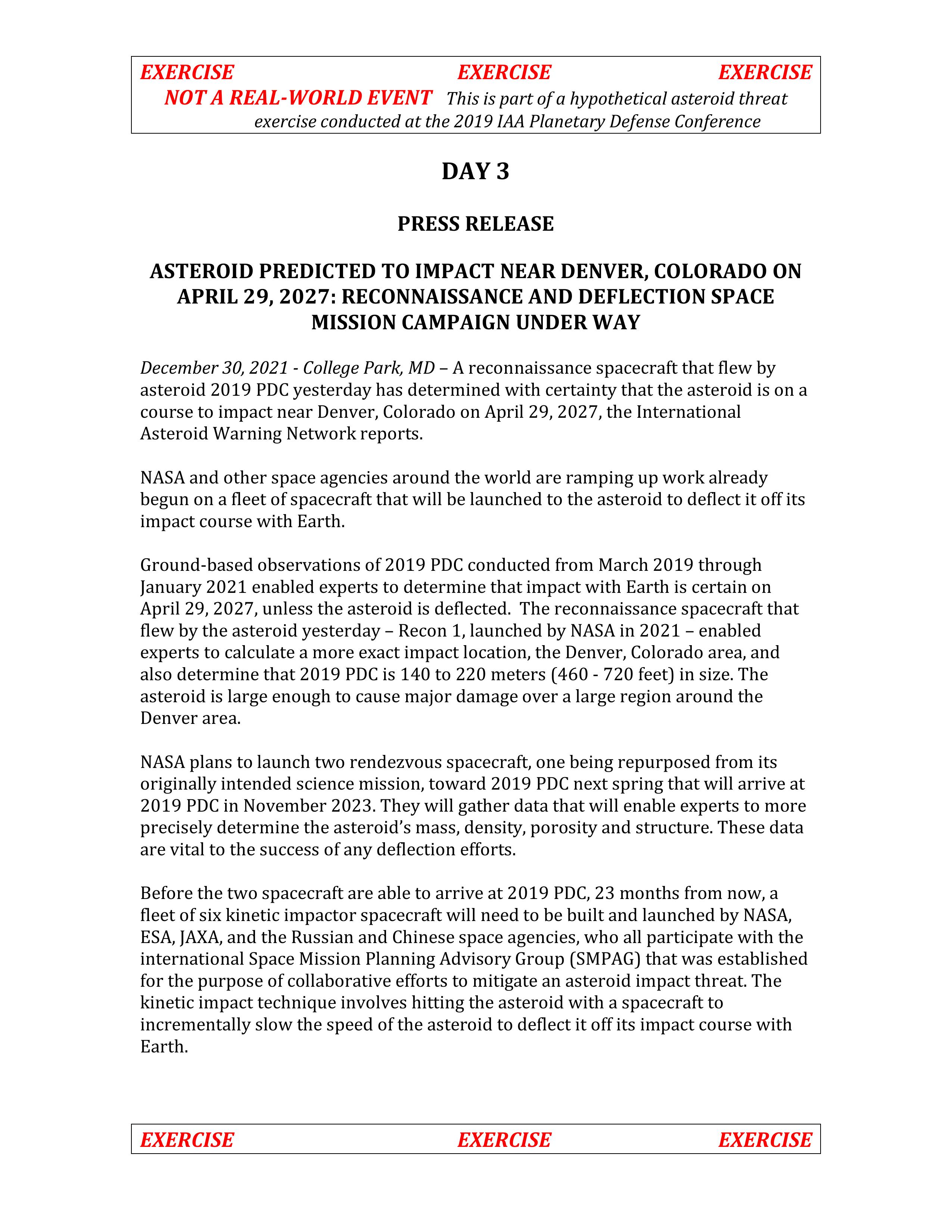
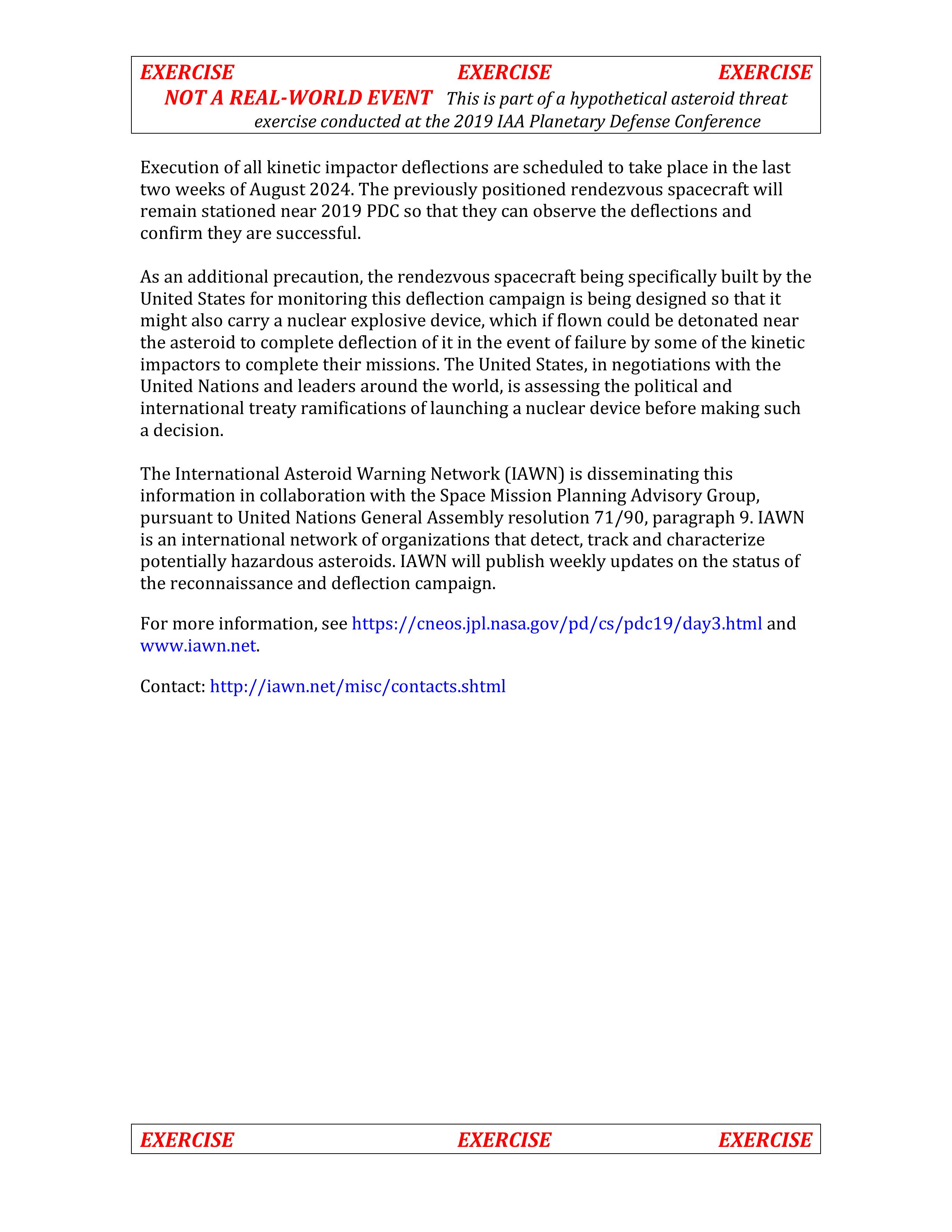 Follow the live updates from day three in the ESA Operations thread:
Follow the live updates from day three in the ESA Operations thread:
#FictionalEvent
Paul Chodas, manager of NASA's Center for Near-Earth Object Studies #CNEOS, who designed this year's scenario says:
"We have the resolve, we have a space programme, we can prevent this" pic.twitter.com/YpEumRe4co— ESA Operations (@esaoperations) May 1, 2019
Tuesday 30 April: Day two
29 July 2019
The second press release on fictional asteroid 2019PDC is out, and it’s not looking good. Four months after asteroid #2019PDC is detected, observations now show the chance of Earth impact has increased to 1 in 10.
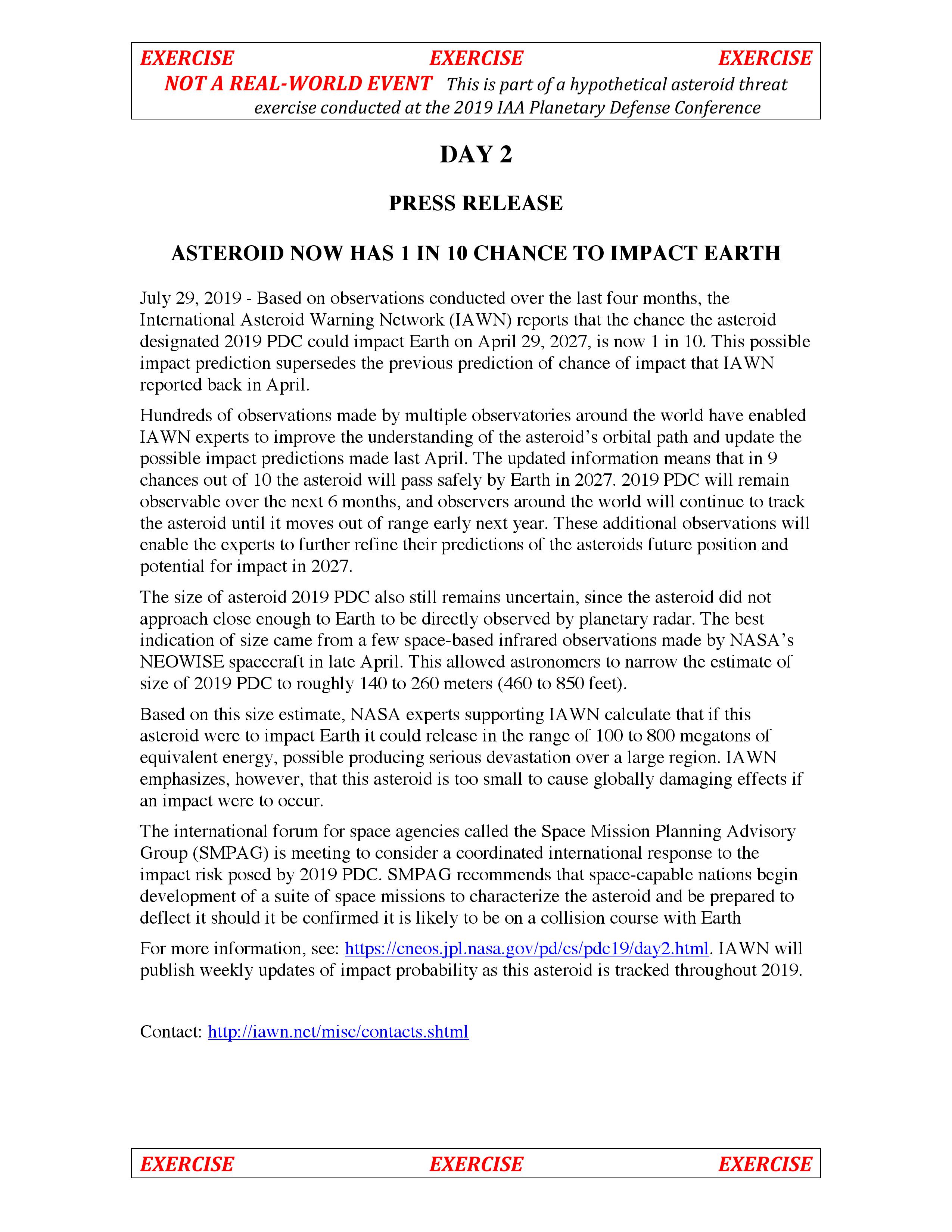
Difficult questions must now be asked. How do we deflect the asteroid? Perhaps it could be exploded? Or could we organise a mass evacuation of areas we think will be affected? Do we have enough information?
Models suggest the asteroid could impact anywhere within a ‘risk corridor’ going from Southern to Western Africa, across the Atlantic and up to North America.
Get live updates on the ESA Operations thread, below:
#FictionalEvent?☄️
Three more months of observations from around the world have refined our understanding of asteroid #2019PDC's orbit, which now has a 10% chance of striking Earth. Experts are performing detailed risk assessments to understand the potential impact effects pic.twitter.com/R4z4fdo5sj— ESA Operations (@esaoperations) April 30, 2019
Once briefed on the latest details, participants to the Planetary Defense Conference split into groups to discuss the recommendations they will put to the “Asteroid 2019 PDC Mitigation Task Force”.
Monday 29 April: Day one
First press release on the detection of asteroid 2019 PDC, similar to what would be released should a real dangerous asteroid be discovered.
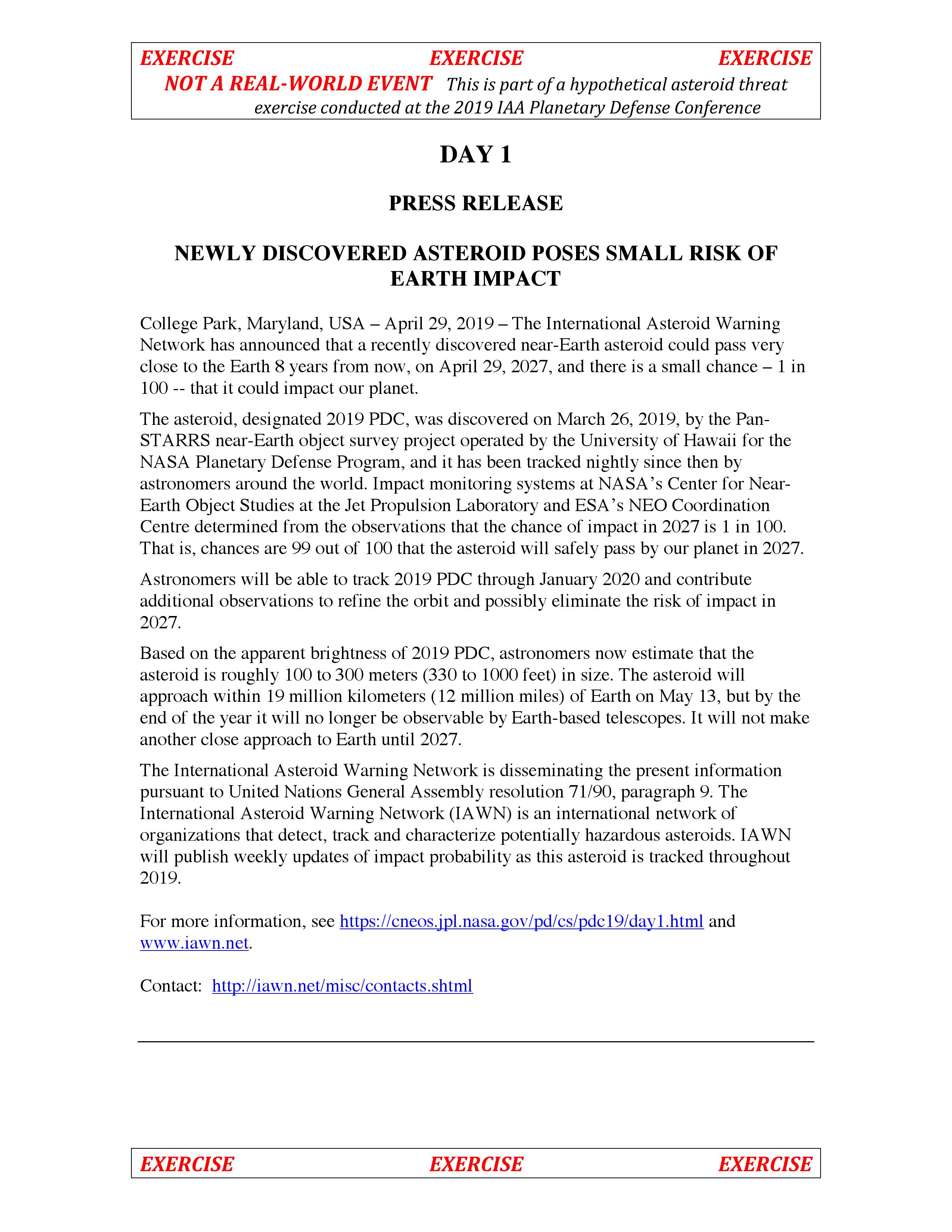 ESA’s Head of Planetary Defence responds to the worrying discovery:
ESA’s Head of Planetary Defence responds to the worrying discovery:
“1 in 100 may not sound like a lot, but considering the damage an asteroid of this size could cause – this is something we would need to take very, very seriously.”
Paul Chodas, creator of this years impact scenario expands on the complexities of the case:

“If asteroid #2019PDC is headed straight at Earth, we won’t know for sure until the year 2020. So how do we make a decision? What do we do now?”
Further updates will be given each day of the Planetary Defense Conference – stay tuned!
Setting the scene: Planetary Defense Conference 2019
Every two years, asteroid experts from across the globe come together to pretend an asteroid impact is imminent. During these week-long impact scenarios, participants don’t know how the situation will evolve know from one day to the next but must make plans based on the daily updates they are given.
For the first time, ESA will be live tweeting the hypothetical impact scenario from the heart of the Planetary Defense Conference (PDC) in Washington DC – so you’ll find out the ‘news’ as the experts do. What will they do? What would you do?
Scroll down for live twitter updates.
This year’s asteroid – ‘2019 PDC’
The scene has been set for this year’s hypothetical impact scenario. Although realistic, is it is completely fictional and does NOT describe an actual asteroid impact.
— An asteroid was discovered on 26 March 2019 and has been given the name “2019 PDC” by the IAU’s Minor Planet Center.
— Initial calculations suggest the orbit of 2019 PDC will bring it within 7.5 million km of Earth’s orbit. (Or, within 0.05 AU of Earth’s orbit. One AU is the mean distance between the Sun and Earth, equal to 149 597 870.7 km).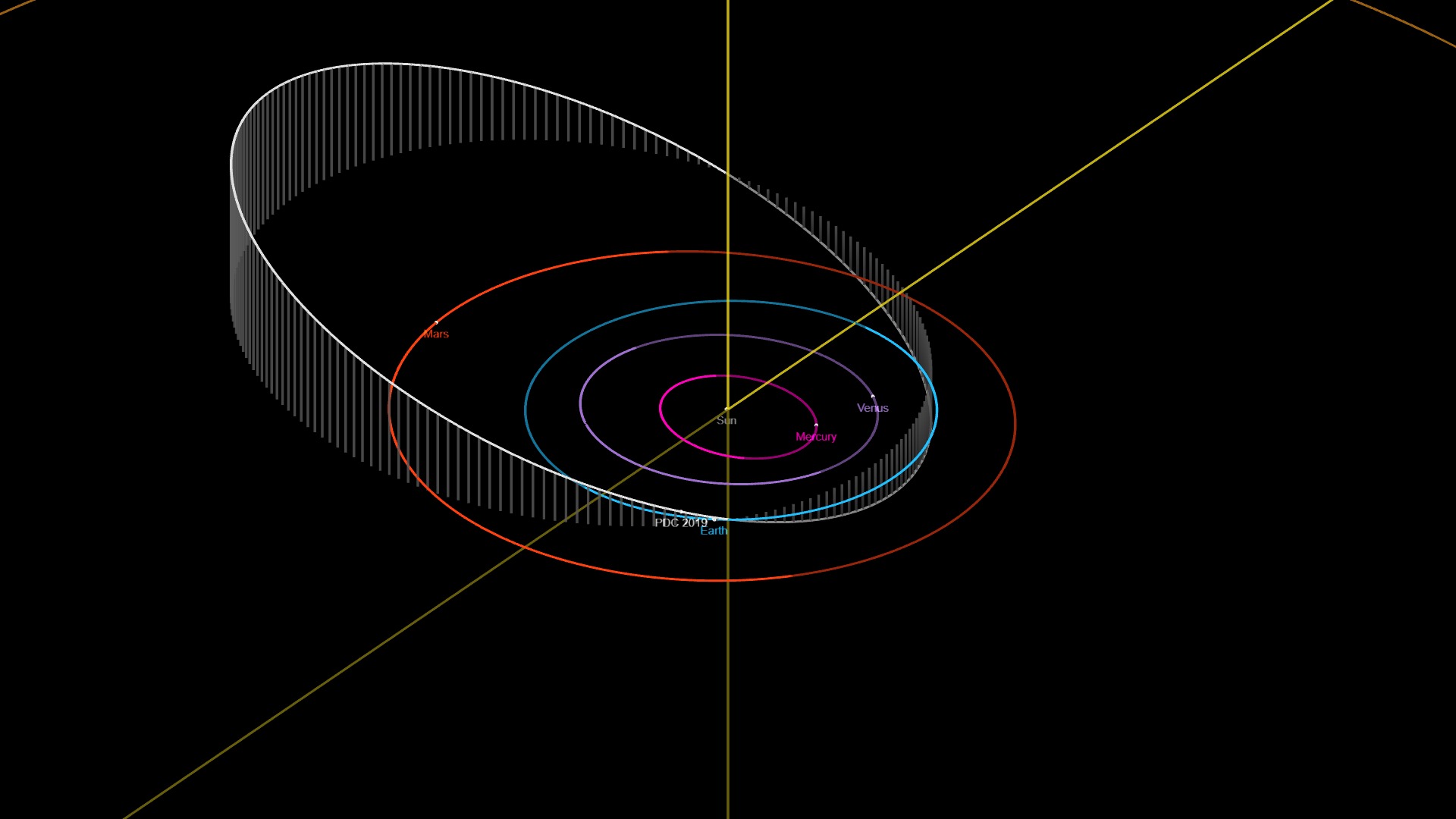 — 2019 PDC is travelling in an eccentric orbit, extending 2.94 AU at its farthest point from the Sun (in the middle of the main asteroid belt), and 0.94 AU at its closest. It completes one full orbit around the Sun every 971 days (2.66 years). See its orbit in more detail here.
— 2019 PDC is travelling in an eccentric orbit, extending 2.94 AU at its farthest point from the Sun (in the middle of the main asteroid belt), and 0.94 AU at its closest. It completes one full orbit around the Sun every 971 days (2.66 years). See its orbit in more detail here.
— The day after 2019 PDC is discovered, ESA and NASA’s impact monitoring systems identify several future dates when the asteroid could hit Earth. Both systems agree that the asteroid is most likely to strike on 29 April 2027 – more than eight years away – with a very low probability of impact of about 1 in 50 000.
— When it was first detected, asteroid 2019 PDC was about 57 million km from Earth, equal to 0.38 Astronomical Units. It was travelling about 14 km/s, and slowly getting brighter.
— As observations continue, the likelihood of an impact in 2027 increases. Three weeks after the discovery, after observations were paused during the full Moon (and reduced visibility), the chance of impact has risen to 0.4% – that’s a chance of 1 in 250.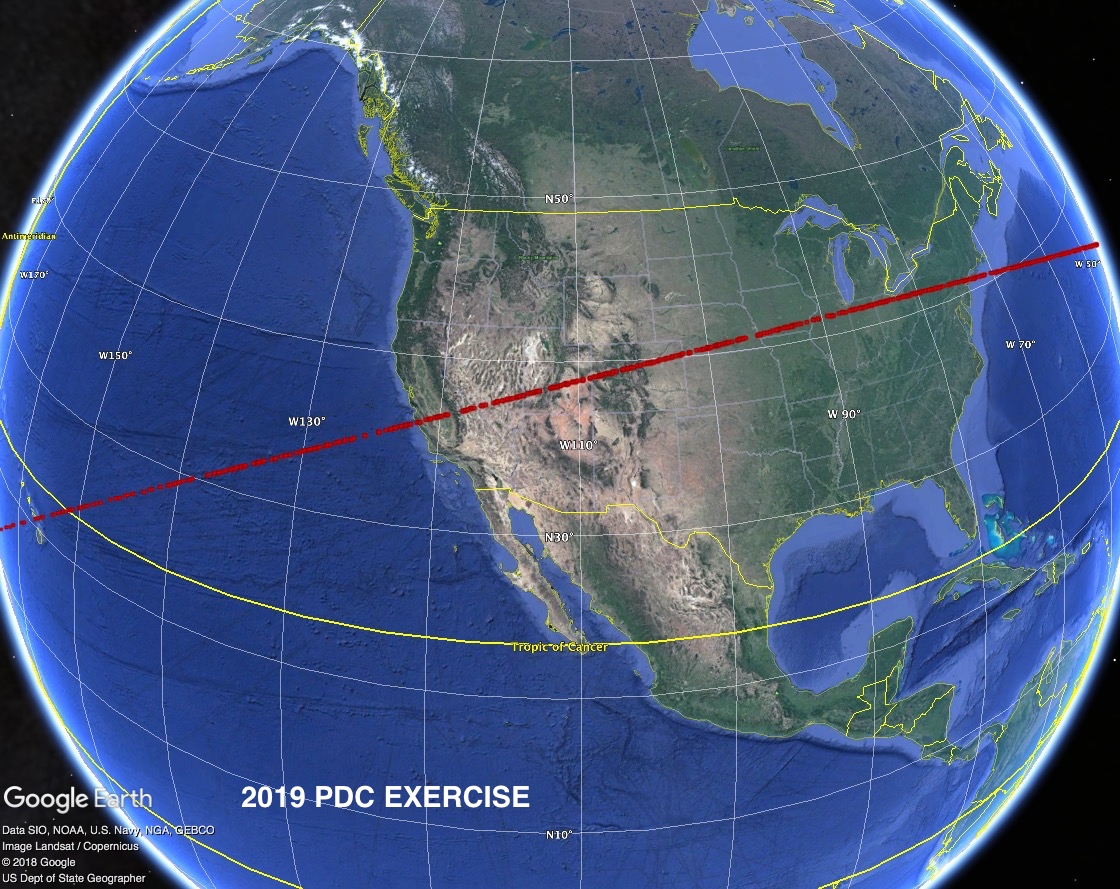 — Very little is known about the asteroid’s physical properties. From its brightness, experts determine that the asteroid’s mean size could be anywhere from 100-300 meters.
— Very little is known about the asteroid’s physical properties. From its brightness, experts determine that the asteroid’s mean size could be anywhere from 100-300 meters.
— Asteroid #2019PDC continued to approach Earth for more than a month after discovery, reaching its closest point on 13 May. Unfortunately, the asteroid was too far away to be detected, and it is not expected to pass close to Earth until 2027 – the year of impact.
— Astronomers continued to monitor the asteroid for a month after its initial detection, which provided them with more information about the object’s trajectory, and have now discovered that the chance of impact is rapidly increasing. By 29 April 2019, (the first day of the Planetary Defence Conference), the probability of impact has risen to 1 in 100.
What’s to be done?
Follow @esaoperations on Twitter for live coverage of the conference, and find daily updates on the asteroid impact scenario here, beginning on Monday, 29 April.
Tweets by esaoperations https://platform.twitter.com/widgets.js

Discussion: 30 comments
Very cool! I wish I could be there!
Very very cool!!!!!!!!!!!!!!!!!!!!!!!!!!!!!!!!!!!!!!!!!!!
Hello, can and will this message be shared with NASA research in the path to discovering solutions for impact on earth.
In general society see’s these articles which introduces global issues yet you never see what solutions have been found or discovered, which makes feel a need to go out on a limb to express a thought that may provide a solution.
Sometimes the simplest solutions are the best answer, an impact on earth is not a country problem but a global one. Japan, China and the United States have all developed laser technology that perform at a trillion watts. The US Navy have AN/SEQ-3 Laser Weapon System or XN-1 LaWS.
My ignorance in this type of technology may appear obvious as I speak further, just based on the most basic understanding of what other countries are doing today, its my feeling that a joint task force (JTF) could be assembled from all the countries, to develop a laser strong enough to cut materials in space. Breaking large objects into smaller manageable sizes. Then either leaving them for the earths atmosphere to burn and break them up or to diver them away from earth.
Again, I’m completely ignorant to what is really out there, but it always seems funny how the most obvious solution which is at mankind’s reach is the very one we all fail to reach for. Then we open an article that defines a solution that leaves everyone reading then asking the most basic questions.
If you break up a large object with a laser (or projectile impact, or nuclear warheads, whatever) you can’t guarantee that the resulting smaller objects will burn up in the atmosphere. The trajectory will also be unpredictable. Multiple impacts in unknown locations will probably be a worse outcome, in most cases, than an impact by a larger object at a known location.
What if it hots the moon instead of the earth?
*hits, not hots.
Unbelievable that I’ve never thought of that…. wow. That’s scary.
In fact could lead to a bigger disaster.
Oh Word
All this asteroid talk fits into Werner Von Brauns warning. Aliens next? I say get a large roll of toilet paper because these asteroids look like turds. Maybe we can just wipe them away?
Very good information. Never knew a bi-annual summit has been going on with these scenarios. As a former EMT. I participated in various mock disasters and it enabled to uncover potential weak areas that wouldn’t have necessarily come to light any other way. I applaud their efforts. Now, Id like to know what is Plan A, B and C right now?
Isn’t it possible to develop some type of ” NEO Redirection Module?” I’m imagining something containing a fuel source and large thrusters that could be placed on the asteroid. Essentially use the thrusters to alter the trajectory.
I have the exact same idea! Been working on it for a couple of years. It’s really a no brainier if Earth has a Solar system SWAT TEAM.
I think having early warning stations throughout our system precisely programmed AI, to seek out very fast moving objects, calculate speed, trajectory, place of origin and destination. I’m imagining Solar powered satellites, which cross check with one another for moving objects. Then triangulate the anomaly’s presence for nearer satellites to be instructed to ignore or send a signal to the killer satellites.
These satellites I envision might be the size of a beach ball or a VW BEETLE stuffed with all of the nano technologies necessary for laser communications or laser weapons.
Just an idea I’m sure many of you other people have your own great ideas.
I’m not a scientist nor engineer, just a humble cultural anthropolog, thinking alot about our world for my children and grandchildren and beyond.
I have a hard time taking this seriously. Seems like verve on browns prediction an asteroid as fear is in play by NASA. Look up bird on ground warns of fake asteroids
This is not a new idea. I assure you this is one of many options that folks/space agencies are working on.
I hope we have a better plan than, bending over and kissing our asses goodbye!
Yes, there are ways that asteroids can be nudged into safer trajectories. … … If that is not possible… The experts say we are safe from all the known *large asteroids for around 100 years from now, so you won’t need to worry about them. .. Medium size asteroids can be observed when they are still a long way out, and their trajectories can be calculated to determine approximately where on the Earth they could hit. Note that 71% of the Earth’s surface is oceans and there is also a large proportion being deserts, jungle, forests and arctic areas. .. Experts also say that given months of warning time, any nearby communities can be evacuated to safer areas.
Will there be a livestream, as in the years before??
https://www.youtube.com/channel/UCpq_pj8aLeFu-0i4Je8_JsQ
Yes! Follow live here: https://twitter.com/NASA/status/1122853154721341440
https://sservi.nasa.gov/event/2019-iaa-planetary-defense-conference-live-stream/
2019 IAA Planetary Defense Conference live stream
April 29 @ 8:00 am PDT – May 3 @ 5:00 pm PDT
Sono d?accordo con Rudiger Jehn
Sono d’accordo con Rudiger Jehn.
Ok I know that this is a fictional asteroid impact, but has anyone ever thought that the PDC and NASA might be doing this simulation because there is a real and plausible asteroid that is right now headed for Earth and that they are really telling us by doing this exercise. By doing it this way they will not cause a world wide panic. That is just my thoughts about this so called scenario. it’s just cuz some of their words they used suggests that this is a real asteroid, and this is going to happen. food for thought.
This hypothetical impact scenario is a useful way of getting astronomers, asteroid scientists, communicators, emergency response teams and more to coordinate, and understand how they can be most useful to each other should an event like this occur. You can find past practise impact scenarios from previous Planetary Defense Conferences here: https://pdc.iaaweb.org/?q=content/past-conferences
This is not the first such exercise.
This my small cent, and ignorance or like a joke…
I think can we install big big net like caching big fish.. Put into orbit where the location of satilite, so if we locky and catch this asteriod we can investigate further.
Sorry again my ignorance…
I know nothing. I’m just an interested person who highly appreciates the shared knowledge of the informed/educated. Besides the moon, are there any other bodies close enough to Earth that could cause a disruption if they were hit instead?
No.
The Asteroid in this scenario is way to small to
A) alter the orbit of the moon significantly,
B) produce big and a large number of pieces that left the surface of the moon, that cause any danger to the earth. There is a small chance that there will be a meteor shower https://en.wikipedia.org/wiki/Meteor_shower in the next months and years, due to possible small pieces that got ejected out of the moon’s gravitational field.
There are things like Lunar meteorites (found on earth) https://en.wikipedia.org/wiki/Lunar_meteorite.We even found parts of mars on earth https://en.wikipedia.org/wiki/Martian_meteorite
If it would hit the moon it would be a GREAT show!! I think the impact explosion would be seen in day light with the naked eye, and the impact crater (2-4 km) would be seen as a red/orange point source in the night (Crater filled with molten rock). Would look like a star at the surface of the moon.
Hitting the earth -> BAD
Hitting the moon -> GREAT SHOW
Melancholia!
Newsletter registration on ESA site is not working. However, many thanks!